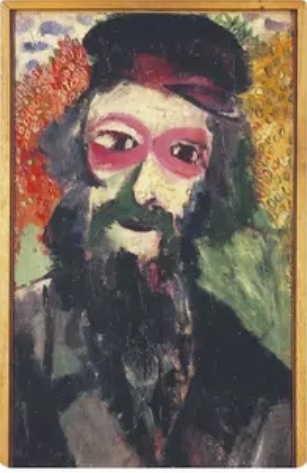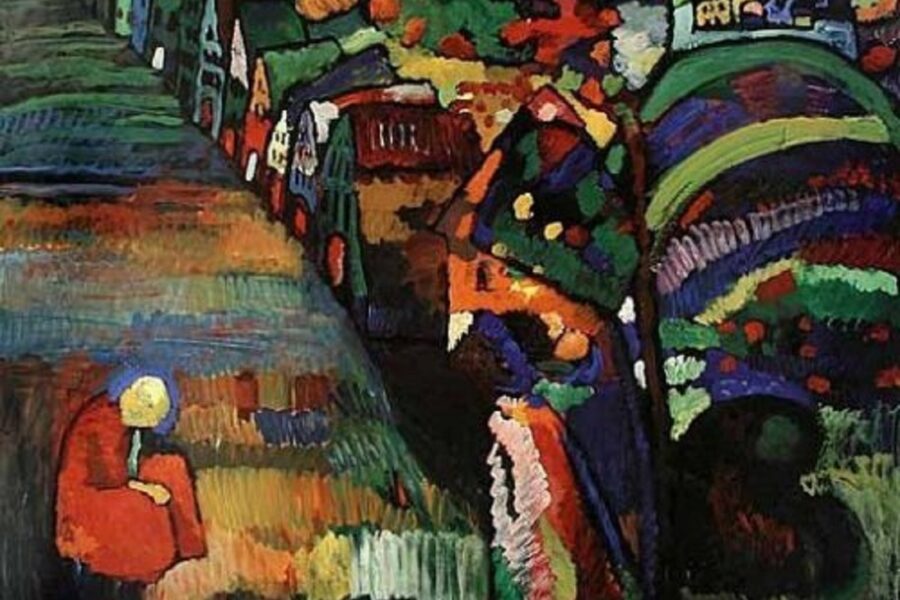[THIS IS AN ENGLISH TRANSLATION OF THE ORIGINAL FRENCH ARTICLE “Le Père de Chagall rentre chez lui” PUBLISHED ON Le Journal du Dimanche ON FEBRUARY 7, 2022.(https://www.lejdd.fr/Societe/apres-60-ans-de-traque-elle-va-enfin-heriter-dune-toile-de-marc-chagall-spoliee-par-les-nazis-4092178)
After 60 years of hunting, she will finally inherit a painting by Marc Chagall looted by the Nazis
Through Pascal Ceaux 3:25 p.m., February 7, 2022

“The Father” (1911), Marc Chagall.
(Mnam-CCI/RMN-Grand Palais/Philippe Migeat/Adagp)
“The Father”, a painting by Marc Chagall, had been stolen from his Jewish great-uncle by the Nazis. Thanks to a law voted in January in the Assembly and soon adopted in the Senate, Orna will recover this work.
When we talk to her about the Father painted in 1911 by Marc Chagall, Orna still sometimes finds it hard to believe. She didn’t really hear about this painting until 2015. A phone call then an exchange of e-mails told her that she was the legal heiress of the portrait stolen from her great-uncle by the Nazis. in 1940 in Lodz, Poland. Here she is, in a moment, immersed in her childhood memory in the middle of an extraordinary story.
“I felt like I was living a legend”, she says today to evoke this “miracle” arising from the past, so far, so close. For her, David Cender was first of all a kind of old uncle, avaricious of confidences, but with an affectionate ritual. “He wore a hat and every time he visited us he made me try it on, she recalls. I was 11 when he died in 1966, and he never talked about the stolen canvas, he was a silent man.”
In the family, as with many survivors, no one talks about the Holocaust. David Cender lost his wife and daughter in Auschwitz, as well as his mother and two sisters. Other parents disappeared into the hell of the extermination camps or the Lodz ghetto. Some were able to be saved, the father and the uncle of Orna, in France, by two families which in Bordeaux and in Charente-Maritime welcomed and helped the persecuted. We know that the great-uncle was a collector, but that’s about it.
However, this one has already been trying for years to reconnect with his Chagall, a superb vestige of happy times. For him, it all started in 1928, when he bought the canvas in Warsaw. “I understand his choice, explains Orna, because it was a very beautiful portrait which magnificently represented Jewish life as it was before the catastrophe of the Second World War.”
“It was a very beautiful portrait that represented Jewish life as it was before”
In 1959, Cender seized the commission created in Germany for the restitution of works of art stolen from Jews. In support of his request, he produces several certificates demonstrating his merits. Witnesses claim under oath to have seen the work hung in his home. However, it was not until 1972, six years after his death, that the spoliation was officially recognized. Moreover, the owner of the canvas has been informed. It’s about… Marc Chagall!
After the war, the painter recovered this painting to which he was particularly attached, especially since it had been taken from him under mysterious conditions when his Paris studio was moved in 1914. According to specialists, the man represented could besides being inspired by the painter’s own father. He lends it for several exhibitions in which it appears under the mention private collection. After the artist’s death in 1985, Le Père was donated to the Beaubourg Museum of Modern Art along with 45 other paintings, 406 drawings, gouaches and books. Then it is exhibited at the Museum of Art and History of Judaism in Paris.
The death of David Cender interrupted the family investigations. In 2012, a new actor in this scenario with twists and turns appears. Mondex is a Canadian company specializing in the search for works of art looted during the Second World War. Its founder James Palmer, supported by a Parisian lawyer, Mélina Wolman, took over the Cender file. “We approached the heirs in Israel and found that they knew very little,” Palmer said.
At the end of eighteen months of research, a final obscure point has been lifted. There was controversy surrounding the dating of the Father, raising doubt. 1911? 1912? Would there have been two separate paintings? David Cender’s ownership was finally confirmed, especially since one of the Mondex investigators knew the painting perfectly and facilitated its traceability: she was working in Beaubourg when it was exhibited there, and presented it to visitors.
Negotiations are started with the French government, which supports the principle of a return to the legitimate owner. But the law requires that any restitution of a painting belonging to the national collections be confirmed by a vote of Parliament. The National Assembly voted in this direction in January and the Senate must decide on February 15. There is no doubt that it will confirm the decision of the deputies. Then, Orna will be able to find her Father, for her an authentic figure of a vanished world. “I appreciate the attitude of the French government, which has been very open, she said, and it is a victory for justice and dignity and for respect for the victims.”
The heiress does not yet know what she will do with her inheritance. All options are open. A ceremony could be organized in Paris for the restitution where Orna would like to see the members of these French families who, in Bordeaux and Charente-Maritime, saved his family. This carrier of such a painful memory has only one and only regret. “I so wish it was my great-uncle, David Cender, who got this result before he died.”


